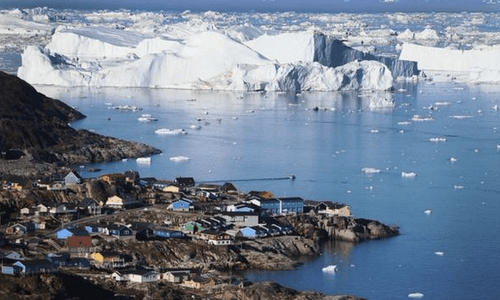
One of World’s Fastest Melting Glaciers May Have Lost Largest Chunk of Ice in Recorded History

With the world’s glaciers melting at record rates, the Jakobshavn—Greenland‘s fastest-moving glacier and one of the fastest melting in the world—may have lost its largest chunk of ice in recorded history.
Massive calving event on Greenland’s fastest melting #glacier http://t.co/aRvxQcDOvf Images: http://t.co/fmoHfapp4o pic.twitter.com/VC4arPdVw0
— The Ice Age (@Jamie_Woodward_) August 20, 2015
The Washington Post reported that members of the Arctic Sea Ice Forum examined satellite images of the glacier between Aug. 14 and Aug. 16 and found that a large chunk of ice (an estimated total area of of 12.5 square kilometers or five square miles), had broken away from the glacier’s face. The amount is quite possibly the largest ever recorded, some members have speculated.
According to forum member Espen Olsen, this loss is “one of the largest calvings in many years, if not the largest.” (Calving is the sudden release and breaking away of a mass of ice from a glacier, iceberg, ice front, ice shelf or crevasse).
As the Post noted in its report, calving isn’t unusual for this area in Greenland due to rising air and sea temperatures in the Arctic. “As of 2012, the glacier was pouring out ice at a speed of 150 feet per day, nearly three times its flow rate in the 1990s,” the report stated.
One of the world’s fastest melting glaciers may have just lost its biggest ice chunk on record http://t.co/Y0CnIXwDYL pic.twitter.com/i8WbaBaIm1
— Post Green (@postgreen) August 19, 2015
“Overall, I don’t think that they really can nail the ‘largest’ [calving event] or not,” he wrote in an email to the publication. “I wouldn’t get too excited on this, even though it is not good news.” He added that the satellite images the forum members observed were only spaced by one full day and the ice loss could have broken off in separate smaller events instead of one giant calving.
Even if this event isn’t the largest ice loss recorded on the glacier, as you can see from these satellite images captured on July 31 and Aug. 16 of this year (just two weeks apart!) by Joshua Stevens, a senior data visualizer and cartographer at NASA’s Earth Observatory, the Jakobshavn is going through tremendous ice loss.

 233k
233k  41k
41k  Subscribe
Subscribe 